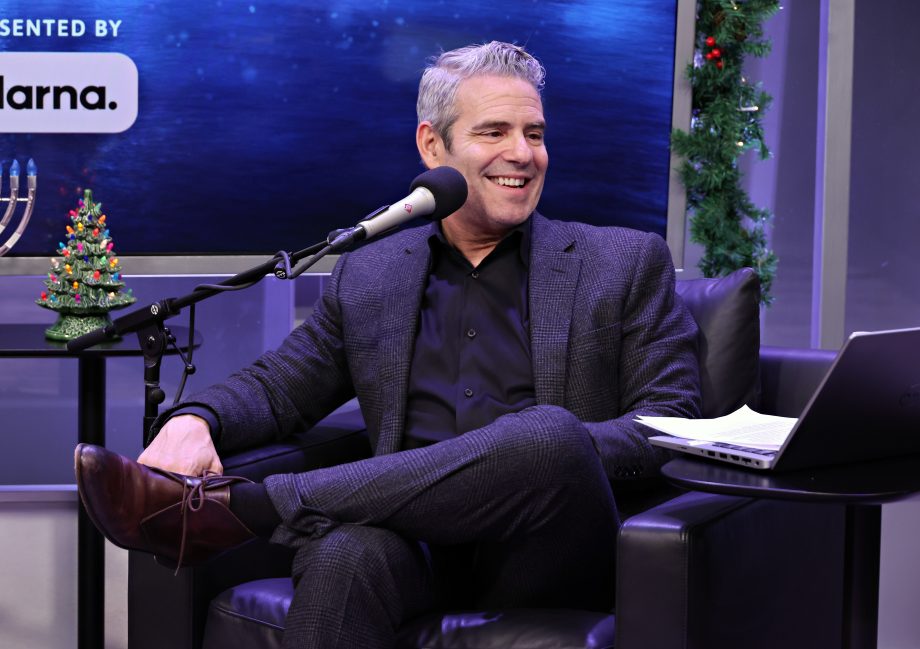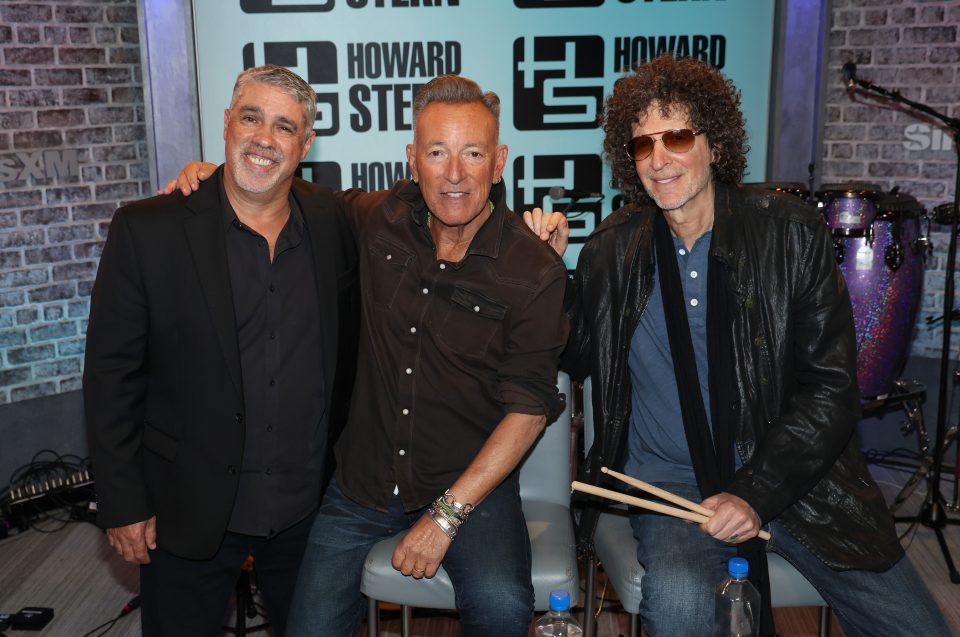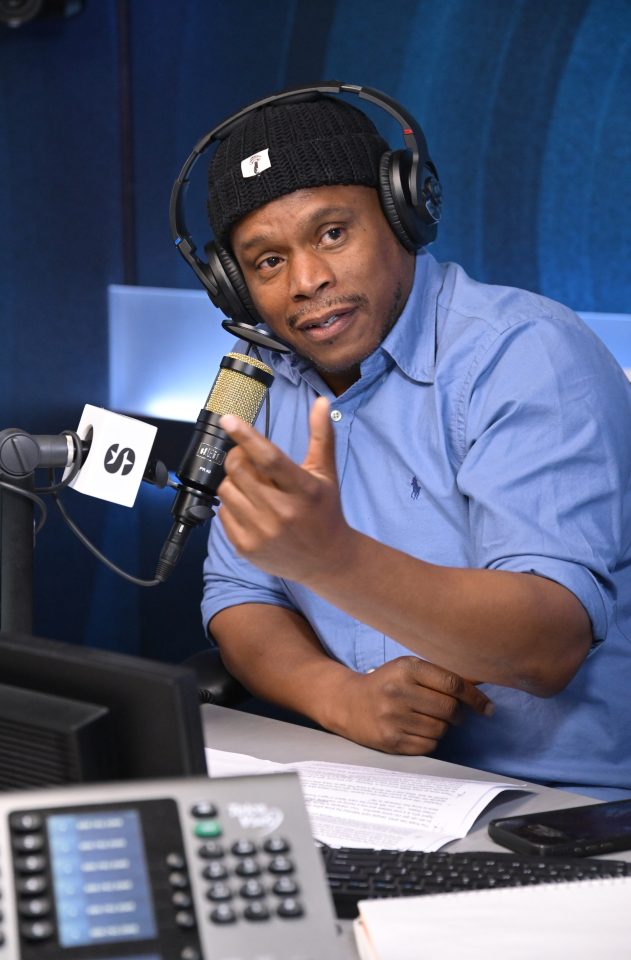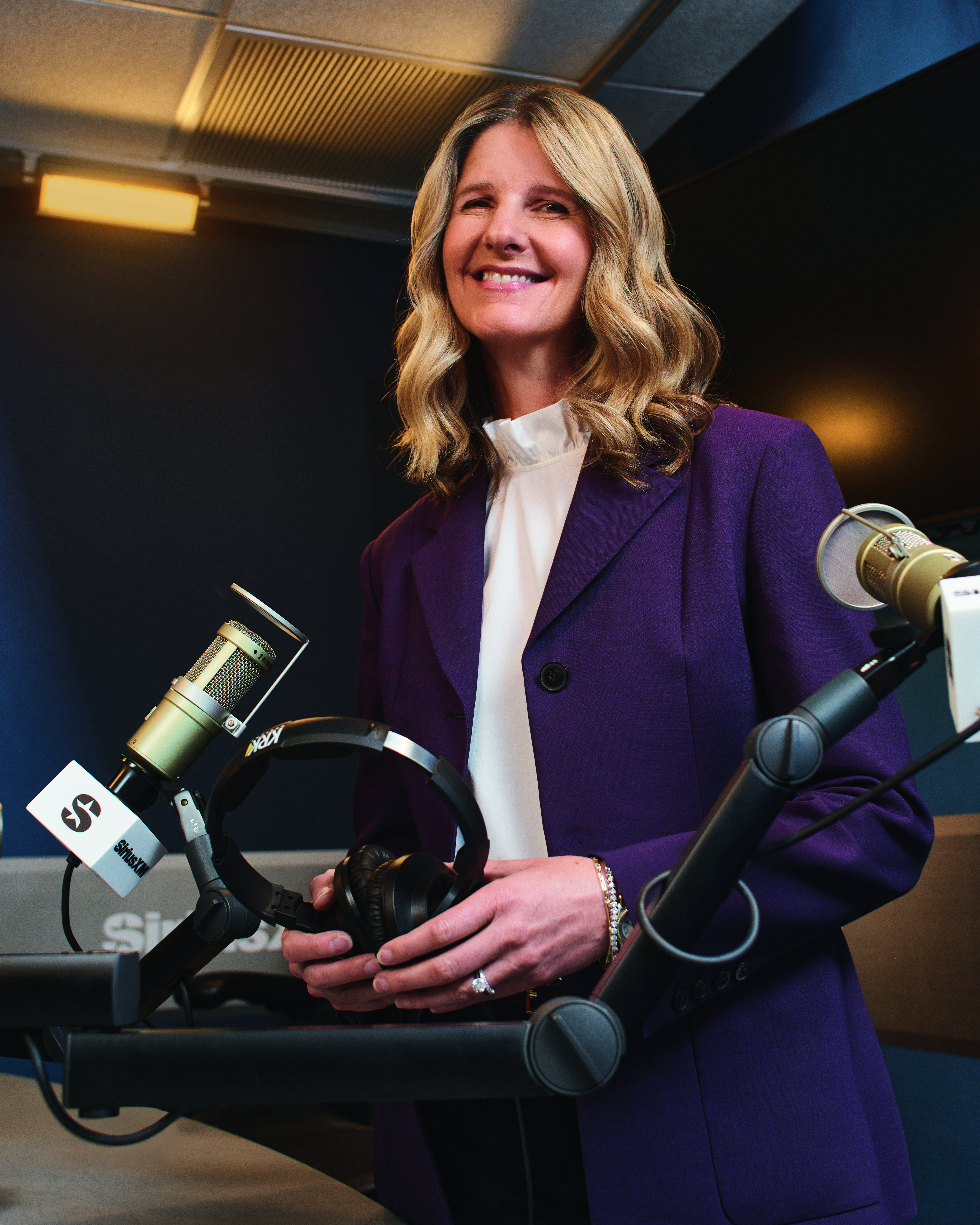In her high-rise office at SiriusXM’s Midtown Manhattan headquarters, CEO Jennifer Witz keeps a four-foot-by-three-foot collage of concert tickets—featuring the $10.50 stub from her first-ever show, a 1982 performance by Hall and Oates, as well as tickets to a 1993 Simon and Garfunkel show, Metallica’s 2000 spectacle at Giants Stadium, and a 2010 Paul McCartney concert to celebrate SiriusXM reaching 20 million subscribers.
Music was what drew Witz in 2002 to a position in finance at Sirius, the then-new satellite radio company. Her first job had been in banking, working for garbage and hazardous-waste clients. “I decided I had to find my way in to be around music,” Witz says. More than two decades later, Witz, 56, became the CEO of a sprawling audio entertainment business, one that includes music, yes, but also news, sports, podcasts, and an advertising business. She also must navigate some areas even further from the music world—like the impact of new-car sales, road safety regulations, and satellite launches into space.
SiriusXM—originally designed to be a techy upgrade to car radio listening, without the commercials and service gaps—is now an $8.7-billion-in-revenue Fortune 500 company for the first time, after spinning off from Liberty Media in late 2024. Yet despite its status as a home for some of the most popular entertainers in America and a remarkably healthy, high-free-cash-flow business model admired by the likes of 35% shareholder Berkshire Hathaway, it stares down several existential risks: competition from on-demand streaming audio; a declining and aging subscriber base; and, years beyond that, a world where its core domain—the car—is self-driving, a place for passengers to not just listen to audio but watch its competitors, TV and video.
New to the Fortune 500, SiriusXM is home to some of America’s most popular podcasters and hosts. It’s also facing an aging user base and steep competition in the streaming-audio era.
Underlying all that is a harsh reality: The company that seemed like sci-fi when Witz joined 23 years ago—voices beamed from space to your car!—has now become something of a dinosaur. Witz is tasked with convincing subscribers that SiriusXM’s always-on, channel-based listening experience is still worth tuning in to.
A photo portrait of Howard Stern, the now 71-year-old talk radio personality who helped build the foundation of SiriusXM’s 33 million subscriber base, is another memento Witz keeps in her office—and a reminder of what keeps the lights on.
Talent has always been at the core of the company’s business model, and its lobbies and hallways are where the magic happens. Super-podcaster Alex Cooper, whose show Call Her Daddy started as a sex and relationships podcast, runs into John Mayer in SiriusXM’s L.A. office and persuades the musician and notorious bachelor to spontaneously join her on her channel Unwell On Air. Elton John and Brandi Carlile record with Stern in New York, and Andy Cohen and Jon Hamm host a town hall.

While podcasting is still a relatively small part of the company’s business, the bets on hosts that SiriusXM has made have largely paid off: Eight of the top 20 U.S. podcasts, according to Edison Research, are from SiriusXM’s stable—far beyond its next-closest competitors, iHeart and Wondery, which each have two.
Thirty-year-old Alex Cooper has been SiriusXM’s most-publicized get, with a blockbuster deal carefully described as “up to” $125 million (SiriusXM has not confirmed this amount). Cooper’s Call Her Daddy podcast started in 2018 as a raunchy sex and relationships show for young women, and has morphed into an interview show that has become a celebrity must-do. (It’s ranked No. 4 on Edison’s chart, with 3.6 million listeners.) Meanwhile Ashley Flowers, the top female podcaster in the U.S. and the force behind the true-crime podcast Crime Junkie, is nipping at the heels of the nation’s perennial No. 1 podcaster, Spotify’s Joe Rogan. Conan O’Brien and the guys from SmartLess (Will Arnett, Jason Bateman, and Sean Hayes) all have SiriusXM deals. Howard Stern is still on the platform, though the upcoming decision of whether to renew his reportedly $100-million-a-year contract will be closely watched.
In a growing and rapidly changing podcasting sector, it may come as a surprise that a two-decade-old satellite radio outfit is such a powerhouse. Indeed, even the average SiriusXM listener is likely not aware of the breadth of the platform’s offerings across its more than 400 channels. Users are unlikely to encounter all that expensive, buzzy content unless they happen to channel-surf into it—a vexing problem in the era of algorithmically determined personalized recommendations in streaming audio and video. That’s because SiriusXM’s satellite technology was its strength—until it became a weakness.
In the 1990s—before podcasting, before widespread use of the internet—lawyer Martine Rothblatt decided that the problem of spotty radio service with limited range had a solution, and it was in space.
Rothblatt, and partners she later brought on, pursued a then-cutting edge idea: deliver reliable radio service across the entire contiguous United States through satellite technology. Sirius launched its first satellite on June 30, 2000. The achievement was so important to American capitalist space experimentation that a backup Sirius satellite is displayed in the Smithsonian’s National Air and Space Museum. A rival company, XM, launched its own satellite in 2001, and the two companies merged in a $13 billion deal in 2008.
Meanwhile, back on Earth, the companies inked deals with automakers including GM, which agreed to factory-install in its cars the chipset required to convert XM’s satellite signal into radio—allowing it to acquire new subscribers among car owners, at a low cost. The platform peaked at 34.9 million U.S. subscribers in 2019.
Cable TV had changed the television landscape, and linear AM/FM radio was overdue for some disrupting. Chief content officer Scott Greenstein, who came on full-time in 2004 after a stretch as chairman of USA Films (a predecessor of Focus Features), said there were plenty of problems with terrestrial radio that satellite channels could fix: There were too many commercials. Hosts couldn’t talk for too long, curse, or play explicit music.

Greenstein wooed Stern, a wildly popular radio shock jock who was syndicated across the country and had a late-night TV show, to SiriusXM’s uncensored air. (In the mid-2000s, Federal Communications Commission regulators were cracking down on “indecency”—but those rules didn’t apply to satellite radio.)
Sirius subscribers grew from 1.1 million at the close of 2004 to more than 6 million by the end of 2006.
But satellite’s reign as the hot new audio technology was short-lived. In the early 2000s, the rise of the internet and smartphones quickly changed everything. Then in 2007, a mail-in DVD company called Netflix began to offer video on demand to its early-adopter subscribers. And with that, the streaming era began, with its intense focus on algorithmic personalization for targeted advertising and recommendations. SiriusXM was simply not set up to compete: Its technology meant that it had almost no information about its subscribers.
“The great thing about satellite radio is it’s available everywhere,” explains COO Wayne Thorsen, “but it was broadcast from a satellite. There’s no return path for listening data or getting the chance to change the content based on how people were listening to it.”
As listeners grew more accustomed to Spotify and Apple Music, that lack of data started to become a real weakness. After SiriusXM subscribers drove off the car-dealership lot, the company didn’t know what they listened to or when. Did subscribers who joined for Stern gravitate to anything else? When did a listener change the channel or unsubscribe?
In 2019, SiriusXM acquired music-streaming service Pandora, including its subsidiary, adtech leader AdsWizz, for $3.5 billion, and built its first major advertising business. Today advertising contributes 20% of SiriusXM’s revenue, compared with 80% from subscriptions.
Also in 2019, SiriusXM debuted 360L, a combined platform that promises reliable satellite service, and comes with the benefits of data-driven streaming, like personalized recommendations. This year, half of new vehicles sold with SiriusXM will have 360L, but mass adoption of the new hardware is slow. It’s not as simple as buying a new smartphone or speaker: The vast majority of SiriusXM subscribers drive cars without 360L, with no ability to upgrade until they buy a new car.
Today’s listeners don’t think of SiriusXM as being at the forefront of innovation. There are at least 125 million cars on the road with SiriusXM’s technology installed that don’t currently subscribe.
The tech, even in cars equipped for it, can be clunky, and the hardware requirements of satellite mean the company is hardly nimble: It took years for SiriusXM to launch fully in Teslas because of the company’s high standards for software. “Doing things in a car is a multiyear plan,” Thorsen says. “Launching satellites is a multiyear plan.”
Driven by new-car sales, the company has always attracted an older, more affluent customer; its definition of “young” is under 45. There are channels for fans of Phish, Dave Matthews, the Beatles, Eminem, Kenny Chesney, and the Grateful Dead. (For Witz, a Gen Xer, a pop-up Def Leppard channel was a hit.) Sports fanatics may subscribe for live play-by-plays of NFL, MLB, and NBA games they can’t otherwise access. The success with this age bracket may not last: Soon, forty-somethings will have grown up with Spotify, attached to curated playlists and on-demand listening. SiriusXM positions itself as a way to add value to music streaming—a tune-in-and-see-what’s-on respite for the decision-fatigued, with curated selections and a DJ with personality.
But at $24.98 a month for an all-access plan (with lower and higher tiers available), SiriusXM is pricey compared with $11.99-per-month Spotify—and is easy to cancel in an era of subscription burnout or during economic hard times.
That’s a problem, says Morningstar analyst Matthew Dolgin: “You can pull a whole bunch of different levers, and not change the fact that someone else is offering access to essentially all music ever created, for much less than you’re charging.” The rest of Wall Street is skeptical, too; the company’s share price is down 18% since the Liberty spinoff.
The company’s best path to making inroads with rising generations has been podcasting, says Greenstein. While competitors like Spotify dived headfirst into a frothy talent market in 2020, SiriusXM focused on the business side first.
In 2020 it acquired the podcasting platform Stitcher and launched the SiriusXM Podcast Network a year later. SiriusXM’s adtech business quietly handles two-thirds of advertising for all U.S. podcasts, even ones it has no other talent relationship with, says chief advertising revenue officer Scott Walker. The market is projected to reach $2.6 billion by 2026, according to a report by the Interactive Advertising Bureau.
SiriusXM channels offer fans a way to go deeper on the voices that they like and identify with: It has signed podcasters with big enough followings and back catalogs to support its 24/7 radio channels. These stars continue releasing their shows on other platforms like Spotify and YouTube—but agree to program extra, exclusive content for SiriusXM, like live call-in programs.
On a Friday night in early spring, outside an ice-cold hockey rink in Everett, Wash., the potential to leverage fandom on a massive scale is visible. Thousands of fans line up wearing sweatshirts that read “full-body chills.” Many have driven hours to see their favorite car-ride companion: Ashley Flowers, host of the true-crime podcast Crime Junkie.

With just a pen and a notebook in her hand, sitting on a couch onstage with her cohost Brit Prawat, the Indiana-based audio mogul holds this audience rapt as she tells the story of a Colorado woman’s gruesome unsolved 1987 murder and the wrongful conviction that followed.
The size of Flowers’ deal with SiriusXM hasn’t been disclosed, but she has the largest listener base of anyone in its podcast network. Edison Research ranks Crime Junkie as the No. 2 podcast in the U.S. this year, with 6.4 million listeners, 65% of them women. “I’ll get Joe Rogan one day,” Flowers jokes.
Alex Cooper, another of SiriusXM’s newer stars, has similarly built a loyal fan base. Having grown her brand substantially since her days hosting a raunchy show for Barstool Sports, Cooper now cultivates an Oprah-like presence, chatting with guests from an election-season Kamala Harris to a recently heartbroken former Bachelor contestant. Fans can listen or watch “wherever they get their podcasts”—which can include SiriusXM, but more often is Spotify, Apple, or YouTube.

Cooper offers a proof of concept for the channel-based approach: She has built a studio and two SiriusXM channels (one plays her favorite music) under the name Unwell, adding podcaster-influencers like her. When you scan to Unwell On Air (channel 786) on SiriusXM, it’s as likely to be playing content from one of these supplementary stars or an old Call Her Daddy episode with a title like “Stop Having Average Sex” as it is a newer Cooper sit-down with an A-lister.
Greenstein, 65, recalls flying to L.A. to poach Cooper from Spotify in 2024, where she had outgrown her reportedly $60 million contract. “A lot of talent as they progress want talent on the other side, in the company they’re with, to understand creative stuff, to have a history in dealing with major stars as they evolve,” Greenstein says when asked what SiriusXM could offer that Spotify couldn’t. “When you look at Spotify, Amazon, Apple…handling major talent on a day-to-day basis is not their strong suit.” Greenstein’s office is littered with signs of that priority, including snapshots of Stern and Lady Gaga.
Deals like Flowers’, Cooper’s, and others have helped build SiriusXM’s reputation as a good place for talent. “It creates opportunity for what we do—and what I do—to be reevaluated from a different lens,” says the hip-hop DJ and radio host Sway Calloway, who came to SiriusXM from MTV in 2011. “I like seeing someone like [podcasters] Joe Budden or Gillie and Wallo be able to get paid the value they’re worth. As long as that’s the case with me, I’ll be happy to stay partnered up with SiriusXM.”

And yet SiriusXM’s if-you-know-you-know vibe has its limitations. Podcasting stars seem reluctant to get pigeonholed as SiriusXM talent. (Cooper wasn’t available for an interview for a story about SiriusXM.)
Backstage in Washington State, bundled up in an oversize Crime Junkie–branded cardigan, Flowers highlights the breadth of her portfolio outside the podcast and SiriusXM. Her Audiochuck network of 20 shows is valued at $250 million. Plus there’s her podcast tour, her mystery and thriller film and television ambitions, and two books.
Flowers is as hungry for listener data as Witz and other SiriusXM executives—and just as frustrated by the lack of information. “Do they come back and listen week to week? Do they let a few episodes build up and then binge us on a road trip?” she asks. “That listening behavior would tell us a lot about how we can better create content for them…[but] it’s so hard to track.”
In 2024 SiriusXM had been promoting its streaming app—a way to compete with Spotify and Apple Music. But for anyone but the most hard-core SiriusXM fans (like New York–based Witz, who listens to CNBC via the app on the city’s subway most mornings), a streaming app that offers mostly radio channels, not on-demand music listening, was a tough sell.
In December 2024, Witz pivoted the strategy. She accepted the reality that the car was SiriusXM’s strongest domain; 90% of users listen there. She announced a “doubling down” on SiriusXM’s “core automotive subscriber segment.” The app and streaming tech are framed mainly as a companion to that car experience.
With the expansion of its 360L technology, SiriusXM can use the app to give users more personalized updates about everything available on the service. It can send push notifications about special live performances or interviews; tailor recommendations to a morning commute, when a subscriber might prefer to listen to news, or an evening drive, when they might want to unwind with music. It’s working on technology to allow car listeners to start a podcast or radio show from the beginning, not jump in halfway through. AI, of course, is threaded throughout these efforts.
“We’re making sure that people understand the breadth of content, rather than just finding a channel and sticking with it,” says Thorsen. “Because it’s not just about attracting users, it’s about keeping them.”
To prepare for economic uncertainty, SiriusXM is launching an ad-supported tier expected to be priced in the “high single digits” monthly—a big deal for a platform whose claim to fame was music with no ads. More than Spotify, Thorsen is looking to Netflix for a guide on how to introduce a lower-cost plan without cannibalizing the existing business, he says.
Where to next for Sirius? Your kitchen or living room, Witz says. Like the car, the home is a “lean back” experience, where people listen to audio while doing other things—cooking or cleaning. “It’s a natural extension of the car,” Witz says. Like car behavior, living-room habits are fast-changing; TVs, not smartphones, are now the primary device for YouTube viewing, and “vodcasts”—video podcasts—are on the rise.
Tech comes and goes, formats and platforms change, but Witz believes that people will always have a special connection with audio—whether it’s music or talk.
“It’s just that intimacy,” she says. “It’s a really powerful medium when you’re alone—but it’s a shared experience as well.”
This article appears in the June/July 2025 issue of Fortune with the headline “Anybody listening?”
